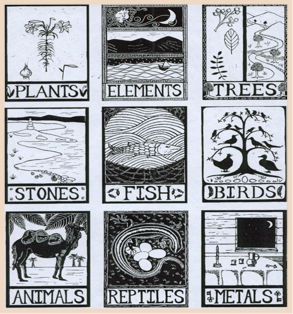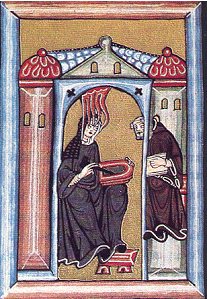|
New address
We
are now in
Wicklow Town.
|
|
Mills & More
7
Bellview Court
Greenhill
Road
Wicklow
Town
Co.
Wicklow
tel:
0404 62387
mob:
086 8429802
|
Healthier, stronger and
more beautiful with spelt
Spelt
is the very best grain ...
Like
none before or after her Hildegard of Bingen (1098-1179), described
the building stones of life itself including the grain spelt. She
wrote the first German book on natural medicine Physica in
which she pointed out the natural healing powers found in trees,
fruits and grains, spices and herbs, animals, birds, fish, precious
stones and metals. Hildegard connected these healing powers to the
health of the whole person.
The simplicity of the
Hildegard diet does not
require measuring the complicated data of calorie charts, vitamin
tables, fat percentages, or fiber content. This simple diet is
totally complete. Supplementation through additional vitamin or
mineral pills is not only unnecessary, but is not recommended.
Hildegard’s frugal diet contains fresh vegetables and fruits in
season, preferably grown in the immediate area. Instead of an
overabundance of various foods from exotic lands, and the cultivation
of gourmet tastes, Hildegard advocates a plain diet which can
nevertheless be delicious and healthful.
The Golden Rules of Life
1.
Your food is the first medicine for a healthy life. There is a
curative power found in the right food and drink.
2.
To preserve and restore your health use the power of natural
medicines. The cosmic energy found in the four elements fire, air,
water and earth can heal your body and your soul.
3.
Make sure you have a natural sleep in balance with enough movement
and exercise. Health can be restored through sleeping and waking.
4.
Make sure you have an intelligent balance between work and
regeneration following the ancient adage: Ora et labora (Pray,
read and work)
5.
Cleanse your body from its poisons by fasting, blood-letting,
cupping, moxibustion, baths and sauna. This is called regeneration
through elimination and secretion.
6.
Transform your psycho-social weaknesses into generous and loving
deeds of spiritual joy, vitality and love for your fellow man.
|

|
St.
Hildegard of Bingen was a
great woman of the Middle Ages, a bright star in the firmament of
Western intellectual and spiritual history. The bright splendor
that radiated throughout her whole life came from a mysterious
phenomenon: the audiovision transmitted to her imagination by
divine command which carried the message of prophecy. That was
her charisma, a fundamentalquality of her life.
Hildegard was born in
1098 at a country estate in Bermersheim near Alzey in
Rheinhessen. Even as a child Hildegard possessed this unusual
capability and saw things which other people could not see; for
example the coloring of a calf while still unborn, or pictures
from far away regions and out of the past. The tenth child of her
noble parents, she was dedicated to God as their tithe from the
time she was very young. Because of her wonderful gift and
natural piousness, Hildegard’s parents entrusted their
eight-year-old daughter to the Benedictine sister, Jutta von
Sponheim, at the Disibodenberg cloister near Kreuznach. The
recluse, Jutta, taught her reading and writing, psalm singing,
needlework, and music.
When
Hildegard was sixteen, she became a nun at the Benedictine
convent. After Jutta’s death in 1136, Hildegard was unanimously
chosen as the abbess, and she led the blossoming convent until
her death in 1181.
For
her first 35 years she lived silently in the isolation of the
daily life of the monastery. The second 35 years can be divided
into five periods.
|
|
Hildegard‘s
Physica – presents nine categories of healing systems--Plants,
Elements, Trees, Stones, Fish, Birds, Animals, Reptiles, and
Metals--and elaborates on their medicinal use
|
|

|
The
first of these five periods began in 1141 when Hildegard was
flooded and inflamed with an intense light from above, receiving
her commission as a prophet. At all times of the day and night
she saw a heavenly screen in front of her, like a shimmering
cloud of light containing words and pictures. She heard wonders
and explanations coming from it and a heavenly voice told her to
write down all she experienced.
Obedient
and dedicated, Hildegard began to write her first theological
work, Scivias (know the ways), which was a gift to her cloister,
Disibodenberg. Scivias, published today in English, is the most
complete documentation of Christian faith in which the secrets of
God are described in words, images, and music. The prophecies
found in Scivias were tested and verified by a papal committee
supervised by St. Bernard Clairveaux. Pope Eugene III personally
authorized and read from Scivias in the Trier Synod in 1147.
Overnight, Hildegard became famous.
In
the second period from 1151 to 1159, an independent Hildegard
founded her own convent on the Rupertsberg near Bingen. This
convent attracted an increasing number of sisters, whom Hildegard
trained in the Benedictine way
of life. Rupertsberg became the meeting place of Europe! As if
attracted by a magnet, thousands came to seek council from
Hildegard.
At
the same time, she started an extraordinary work comprised of
seven books. Liber Simplicus Medicinae, also called Physica, PL),
a handbook on Nature, and Liber Compositae Medicinae (also called
Causae et Curae, CC), a handbook on medicine, werethe first
books. There followed a song book with 77 chants, hymns,
antiphons, sequences, and responsories in a cycle entitled
Symphonia Harmonia Colestium Revolutionum (the harmonic symphony
of cosmic revolutions).
|
|
A
medieval illumination showing Hildegard von Bingen and the monk
Volmar
|
In
her concern for the kingdom of God, this great woman wrote 300
letters to people seeking advice. She corresponded with bishops,
cardinals, abbots, emperors,
popes,
kings, clergymen, and people from various levels of society, both in
Germany and abroad.
From
1158 to 1163, the third period, Hildegard wrote her second
theological book, Liber Vitae Meritorium (the book of life’s
merits), which could be
called
a handbook of life. This psycholtherapeutical book describes the 35
layers of our subconscious, the 35 pairs of virtues and vices. The
vices are the major sickness-causing risk factors of our lives,
whereas the virtues lead us back to health and wholeness.
In
her fourth period, Hildegard undertook four extended mission trips up
and down the Rhine and along the Main and Mosel Rivers. One can
imagine the strain of these preaching tours on a woman over seventy
years old. Her journeys often meant going by boat, on horseback, and
on foot successively.
During
this time (1163-1173), she wrote her last theological book Liber
Divinorum Openum. In this Book of Divine Works, Hildegard describes
humanity in the center of the cosmic circles as God’s most complete
creation. God forms humanity in the
mother’s
womb; the workshop of God begins with conception. There is an exact
description of the biochemical processes of the human body, which
serves
as
an analogy to that which happens in the soul.
In
her fifth period, shortly before her death, Hildegard dictated her
autobiography to two monks. Unfortunately, the only personal work
Hildegard wrote, as opposed to all her visionary works, exists today
only as a fragment. When Hildegard died on the seventeenth of
September 1179, at the age of 81, a bright light glowed in heaven
like a cross, a sign that she was
able
to see the living light. She, who once wrote the wonderful phrase,
the “creation looks upon its creator like the beloved upon her
lover”, was now allowed to return home to the source of light.
With
Hildegard’s death, everything came to an end: her theology,
prophecy, and medicine had no impact on the following generation
whatsoever. Her medicinal book was not even included in
Corpus
Hildegardicum (1180-1190, Rupertsberg).
Hildegard
never practiced medicine! As she testified herself: “I have never
dedicated myself to the
human
studies of the learned.” This is clearly evident from the total
silence in all sources about any such practice. If she ever conducted
studies or research, then at least some mention of such activity
should be found, and yet none ever has. Her medicine would
not
be properly acknowledged for 800 years....
|
Cereal
Habermus
|
Spelt
muffins
|
|
for
breakfast
2
cups water
1
cup freshly coarsly-ground spelt, spelt flakes or spelt farina
1/8
tsp. salt
Combine
ingredients in a large saucepan and bring to a boil. Reduce heat
and simmer for 10 minutes, stirring occasionally. Serves 2.
Serve
with brown sugar, maple syrup, cinnamon, apples and/or chopped
almonds to taste.
|
2
1/4 cups of freshly milled spelt flour, fine or coarse in any
combination
1/4
cup brown sugar or honey
1
Tbsp. baking powder without aluminum
1/2
or less tsp. salt
1
1/4 cups milk
3
eggs, beaten
Tbsp.
cold-pressed sunflower oil
Preheat
oven to 425°F. Grease and flour 12 muffin cups. Combine all
dry ingredients. Add milk, eggs and oil and mix until moistened.
Fill muffin cups 2/3 full with batter and bake for 17 minutes, or
until brown. Variations: add 1/2 cup chopped almonds or 1/2 cup
chopped dates or raisins, or 1/4 cup of each to batter before
baking.
|
|
Upcoming
events:
|
Products
from
Mills and More:
|
|
30st
March Farmers Market at Sonairte (Laytown, Co. Meath)
3rd
April Shiatsu demonstration in Dublin Food CoOp: 12 New Market
3rd
April 8:05pm SGM+AGM of Food CoOp in 12 New Market
13th
April Farmers Market at Sonairte (Laytown, Co. Meath)
27th
April Farmers Market at Sonairte (Laytown, Co. Meath)
|
Grainmills
Flaker
Yogurtmaker
Milk
maker
The
Golden Point
|
...
and finally:
Boasting
About Races
Some
race horses staying in a stable. One of them starts to boast about
his track record. "In the last 15 races, I've won 8 of them!"
Another horse breaks in, "Well in the last 27 races, I've won
19!!" "Oh that's good, but in the last 36 races, I've won
28!", says another, flicking his tail. At this point, they
notice that a greyhound dog has been sitting there listening. "I
don't mean to boast," says the greyhound, "but in my last
90 races, I've won 88 of them!" The horses are clearly amazed.
"Wow!" says one, after a hushed silence. "A talking
dog."
Mills and More


